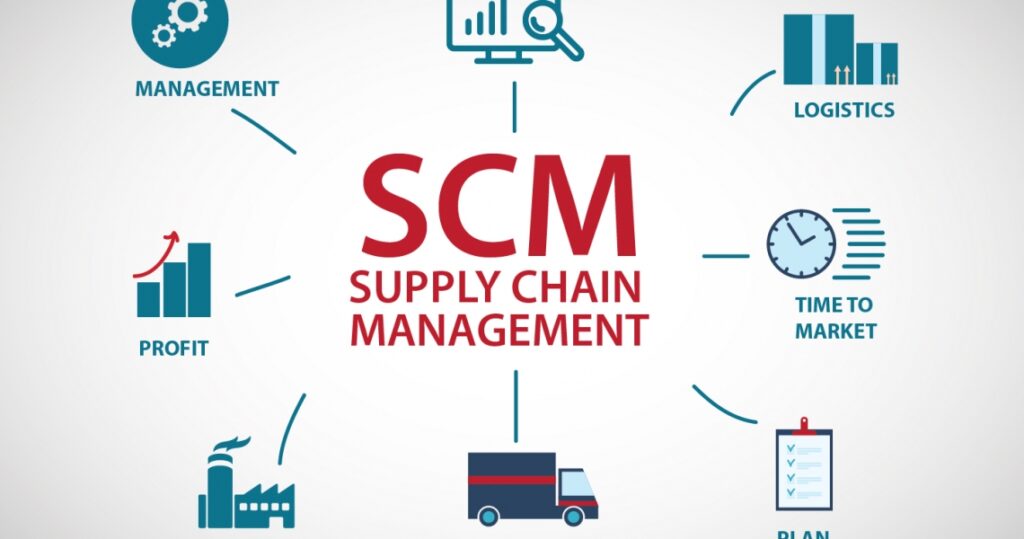What is Logistics and Supply chain Management and it’s Ultimate Concept, 2020.
Table of Contents
What is Logistics and Supply chain management?
“Logistics typically refers to activities that occur within the boundaries of a single organization and Supply Chain refers to networks of companies that work together and coordinate their actions to deliver a product to market. Also, traditional logistics focuses its attention on activities such as procurement, distribution, maintenance, and inventory management. Supply Chain Management (SCM) acknowledges all of traditional logistics and also includes activities such as marketing, new product development, finance, and customer service” – Michael Hugos
Supply Chain Management
As you saw in the video, supply chain management is the process of managing the movement of the raw materials and parts from the beginning of production through delivery to the consumer. In many organizations, operational supply chain decisions are made hundreds of times each day affecting how products are developed, manufactured, moved, and sold.
The complexity of the supply chain varies with the size of the business and the intricacy and quantity of items manufactured, but most supply chains have elements in common, such as the following:
- Customers: Customers start the chain of events when they decide to purchase a product that has been offered for sale by a company. If the product has to be manufactured, the sales order will include a requirement that needs to be fulfilled by the production facility.
- Planning: The planning department will create a production plan to produce the products to fulfill the customer’s orders. To manufacture the products, the company will then have to purchase the raw materials needed.
- Purchasing: The purchasing department receives a list of raw materials and services required by the production department to complete the customers’ orders.
- Inventory: The raw materials are received from the suppliers, checked for quality and accuracy, and moved into the warehouse.
- Production: Based on a production plan, the raw materials are moved to the production area. These raw materials are used to manufacture the finished products ordered by the customer and then sent to the warehouse where they await shipping.

Image1: What is logistics and supply chain management
Logistics
When used in a business sense, logistics is the management of the flow of things between the point of origin and the point of consumption in order to meet requirements of customers or corporations. The resources managed in logistics can include physical items such as food, materials, animals, equipment, and liquids, as well as abstract items, such as time and information.
The logistics of physical items usually involves the integration of information flow, material handling, production, packaging, inventory, transportation, and warehousing. There is often confusion over the difference between logistics and supply chains.
It is now generally accepted that logistics refers to activities within one company/organization related to the distribution of a product, whereas supply chain also encompasses manufacturing and procurement and therefore has a much broader focus, as it involves multiple enterprises, including suppliers, manufacturers, and retailers, working together to meet a customer’s need for a product or service.

Image2: What is logistics and supply chain management
Inbound Logistics
A manager in charge of inbound logistics manages everything related to the incoming flow of resources that the company needs to produce its goods or services. These activities will include managing supplier relationships, accessing raw materials, negotiating materials pricing, and arranging quicker delivery.
Outbound Logistics
A manager working in outbound logistics will be focused on two issues: storage and transportation. He or she will use warehousing techniques to keep the finished goods safe and accessible. Since the products may need to be moved out to a customer at any moment, proper organization is crucial.
Having as little product stored as possible can be advantageous since stored products are not making money, so the outbound logistics manager often has to balance company cost savings with consumer demand. The transportation function is by far the most complex part of outbound logistics.
what is logistics and supply chain management what is logistics and supply chain management
Basic concepts of Logistics and SCM
Inventory Planning
Organizations want to minimize the inventory levels due to its almost linear relationship with the cost. Yet if the demand is forecasted accurately, there would ideally be no need for inventory and the goods will move seamlessly from warehouses to customers.
- That would have been awesome, but it is deep into the ideal world zone. In the real world, the forecasted numbers can only take you so far and some inventory has to be maintained to satiate any surges in demand; the cost of unhappy consumers who are not serviced is often huge, and is immeasurable in most cases.
- Yet overstocks lead to increase in working capital requirements, insurance costs and blocked resources which could have been productive someplace else.
- Making a business forecast has largely been a gut-based process, but is changing rapidly in the era of data-based decision making. The forecast depends on the historical baseline for sales, seasonality (soft drinks have higher sales volume in May), recent trends (Samsung is losing out to competitors when it comes to phones, a declining trend), business cycles (economies go through expansion and contraction every few years), promotional offers (up to 50% off can drive the average fashionista mad) etc.
what is logistics and supply chain management what is logistics and supply chain management
Transportation
The kind of transportation employed by an organization is a strategic decision (it usually accounts for around 1/3rd of the total logistics cost) based on the required level of risk exposure, customer service profiles, geographic area covered etc. Truck shipments take more time for delivery compared to air transport (customers with relaxed turnaround times); is cheaper but necessitates maintenance of higher inventory levels.
- Transportation serves the purpose of not just product movement, but storage as well (not very intuitive). Time spent for delivery means saved time for warehousing, and many times the cost to offload and reload shipments can be greater than the cost of letting the goods stay in the transportation vehicles itself.
- Two basic thumb rules apply for transportation decisions: truck load (TL) shipments are better than less-than-truckload (LTL) shipments as storage space is a perishable commodity (just like a commercial airline does not want to fly with empty seats), and the cost per kilometer decreases as the distance increases (two 500 km shipments is usually more expensive than a single 1000 km shipment).
- The factors which determine the economies of transportation decisions include but are not limited to: distance between the starting and destination points, and density (higher density products take less space — space constraints outweigh weight constraints by a huge margin), stow ability (spherical packaging will lead to more empty spaces compared to cubical) and volume of the goods. Different modes of transport serve different strategic ends (rail, road, air, water etc).
Packaging
The end goals differ: can either be done for end consumers or for logistical considerations. The packaging will then depend on the end goal; form factor plays the lead role when packaging goods for the end consumers, while function plays the lead role in packaging for logistical operations.
Warehousing
It is the back-end building for storing goods. Based on the needs of the organization, it can be in-house or outsourced.
- Primary functions of a warehouse are product movement and storage. Activities such as offloading of the goods coming from the suppliers, the intermediate packaging (if required), and shipping to other destinations (retailers or end consumers) are handled in the warehouse. Similarly, they can also serve as a storage house for handing peak consumer demand to avoid stock out of items, and acts as a buffer between the starting point (usually manufacturing plant) and ending point (think about a typical retail outlet).
- Different distribution strategies can be adopted by an organization based on its needs and infrastructure in place, namely:
- Cross-Docking: Relies on minimal processing at the warehouse level and facilitate seamless connection between “incoming” and “outgoing” goods through technologies such as bar code scanners; becoming increasingly important due to established structured communication between retailers and manufacturers; best for high velocity goods with predictable demand patterns.
- Logistics and E-Commerce
- Transportation Companies During Lockdown, 2020
- 5 Benefits of 3PL Provider For Small Businesses.
- Partnering With a Third Party Logistics Provider – 6 Best Reasons.
- How to Reduce Cost in Transportation Logistics? Master 8 Practical Ways for Cost Reduction
Blog- What is Logistics and Supply Chain Managment.
Supply chain management vs logistics
While logistics is a rather large part of supply chain management, it is still only a part of an even larger picture. The key difference is that, while logistics is concerned with supply chain processes in a vacuum, supply chain management takes a holistic and contextual approach. Think of it like this ….
Logistics asks, “The customer wants [product]. How do we get it to them?”
Supply chain management asks, “How can we improve our supply chain processes to provide more value to our customers and outperform our competition?”
Logistics are vital to your overall supply chain management efforts. After all, if your company literally isn’t able to physically move your products from Point A to Point B, there’s no way you’ll be able to succeed as a business.
But, supply chain management involves much more than physically delivering your products. In involves improving the intertwining and tangential aspects of manufacturing, storage, delivery, and fulfillment in a way that maximizes your organization’s productivity and allows your business to truly soar.
what is logistics and supply chain managementwhat is logistics and supply chain management
The Functions Of Logistics Within Supply Chain Management
If we systematize all areas of logistics that need to be developed for the rational management of production resources, we can single out the following functions:
- Warehouse design and management. This role of logistics in supply chain management covers several tasks at once: from the design of storage facilities to the requirements for storage of products and ending with the introduction of various automation solutions (for example, for machinery intended for transporting goods within warehouses);
- The formation of packages. Packaging, tracking and accounting – all of these tasks allow for end-to-end control of goods on the way to the customer/distributor;
- Transportation of products. This includes work with cargo carriers and vehicles listed in the company’s fleet: planning their routes, calculating fuel costs, etc.;
- Working with customs. When an enterprise plans international delivery of goods, it is very important that during their transportation the goods fully comply with customs requirements and contain all the necessary documentation;
- Working with intermediaries. Intermediaries in logistics are all third-party, non-company resources that are directly involved in the implementation of supply chains. In turn, finding intermediaries with the most acceptable ratio of quality to cost of services, as well as establishing long-term, reliable relations with them are also included in the list of tasks for efficient logistics management;
Blog- What is Logistics and Supply Chain Managment.
Powered By 360Presence
Leave a Replay
what is logistics and supply chain management what is logistics and supply chain management what is logistics and supply chain management what is logistics and supply chain management what is logistics and supply chain management what is logistics and supply chain management what is logistics and supply chain management what is logistics and supply chain managementwhat is logistics and supply chain management




